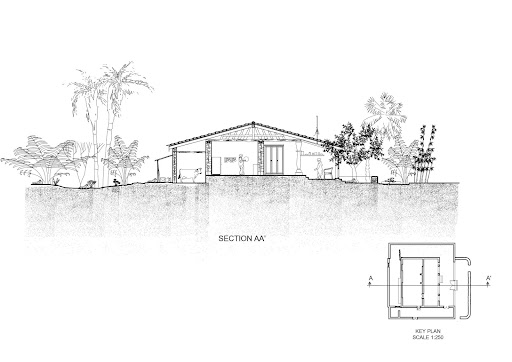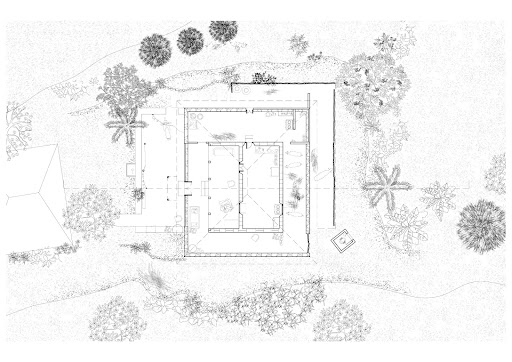Sem 04 / Form and Space Studies
Type, Pattern and Material Phenomenologies
Rupali Gupte
(Course Conducters: Rupali Gupte, Samir Raut, Prasad Khanolkar, Milind Mahale)
(Course Conducters: Rupali Gupte, Samir Raut, Prasad Khanolkar, Milind Mahale)
This course hinged around three ideas: building type, spatial pattern and material phenomenology.
‘Building type’ here is a generic form made of sub-components where sub-components have specific relationships with each other. Building types have evolved over years and have consolidated through needs of climate, aspirations, patterns of living etc. A way of life and living is embedded in their configuration. As a diagram, types spatialise relationships between people.
‘Spatial pattern’ here is referred to as the specific spatiality produced by each of the sub-components, where the articulation of the form of the sub-component shapes its spatiality – (eg. long, wide, squarish, tunnel-like, well-like, etc) This spatiality produces different possibilities of inhabitation. Hence, the spatiality of the sub-component determines the form of life that it can hold. Like type, the sub-components are themselves produced through long histories and embody in them forms of living and practices. In many ways, they stand for patterns of life. Therefore, their spatiality is referred to as spatial patterns. When seen with type, the idea of spatial pattern brings about a specificity to the experience of form.
‘Material Phenomenology’ here is referred to as the study / understanding of phenomenon, when materiality of form becomes instrumental in the experience and phenomenon of space. Materiality here includes the actual material used as well as systems and assemblies of these materials. When seen together with type and pattern, this materiality brings about a specificity to the experience of form.
‘Building type’ here is a generic form made of sub-components where sub-components have specific relationships with each other. Building types have evolved over years and have consolidated through needs of climate, aspirations, patterns of living etc. A way of life and living is embedded in their configuration. As a diagram, types spatialise relationships between people.
‘Spatial pattern’ here is referred to as the specific spatiality produced by each of the sub-components, where the articulation of the form of the sub-component shapes its spatiality – (eg. long, wide, squarish, tunnel-like, well-like, etc) This spatiality produces different possibilities of inhabitation. Hence, the spatiality of the sub-component determines the form of life that it can hold. Like type, the sub-components are themselves produced through long histories and embody in them forms of living and practices. In many ways, they stand for patterns of life. Therefore, their spatiality is referred to as spatial patterns. When seen with type, the idea of spatial pattern brings about a specificity to the experience of form.
‘Material Phenomenology’ here is referred to as the study / understanding of phenomenon, when materiality of form becomes instrumental in the experience and phenomenon of space. Materiality here includes the actual material used as well as systems and assemblies of these materials. When seen together with type and pattern, this materiality brings about a specificity to the experience of form.
Type, pattern and materiality are intrinsically linked to behaviour of the body in space. Specific space and form configurations afford particular possibilities and therefore have a distinct relationship to human behaviour. This course intends to build capacity in students to experiment with and explore the above three ideas, to develop spatial configurations congruent to contemporary practices of the everyday.
This semester we studied type, pattern and material phenomenologies in Chikhali, Malusare near Mahableshwar, Maharashtra. In order to do this we studied one village settlement closely to understand the relationships between the configurations of homesteads and their varied relationships with respect to inhabitation. These studies then became the basis for speculations on types of inhabitation for traveler’s facilities in a given site in Malusare. The given programme dealt with 6 to 8 facilities for travelers, a caretaker’s house, a reception and kitchen space. The students were encouraged to develop the designs including sizes and settings of the travelers’ units, the caretaker’s house, reception, kitchen and dining space based on their typological interpretations of inhabitations for travelers. The course aimed at building capacities in typological engagement (through training in tools of type, pattern, phenomenon-analysis), speculating new forms of inhabitations, developing sensibilities in responding to site contexts and crafting built environment with respect to scale, proportioning, and detailing of material assemblies.
This semester we studied type, pattern and material phenomenologies in Chikhali, Malusare near Mahableshwar, Maharashtra. In order to do this we studied one village settlement closely to understand the relationships between the configurations of homesteads and their varied relationships with respect to inhabitation. These studies then became the basis for speculations on types of inhabitation for traveler’s facilities in a given site in Malusare. The given programme dealt with 6 to 8 facilities for travelers, a caretaker’s house, a reception and kitchen space. The students were encouraged to develop the designs including sizes and settings of the travelers’ units, the caretaker’s house, reception, kitchen and dining space based on their typological interpretations of inhabitations for travelers. The course aimed at building capacities in typological engagement (through training in tools of type, pattern, phenomenon-analysis), speculating new forms of inhabitations, developing sensibilities in responding to site contexts and crafting built environment with respect to scale, proportioning, and detailing of material assemblies.
The work from the course can also be found here.

